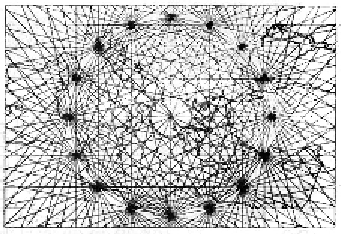Geoscience Reference
In-Depth Information
pictures, then there is a transition from rococo, through classicism till the
era of graphical dissolution into new styles in the 19th century; A. Bačo
(2009) deals with these new styles. R. Rees (1980) also mentions the simi-
larity of artistic and cartographic styles. Specific style can be seen, apart
from parergas, in cartouche and decorative frames (e.g. baroque and ro-
coco with the motives of mystical women, muscular and heroic men with
wild horses, contrasting with romanticism and its shepherds, milkmaids,
trees and corn sheaves). The style of some types of early maps is striking
at first sight, whether it is zone maps, T-O maps or portolan maps with
their typical unmistakable beams of rays (
Figure 11
).
Figure 11
:
Example of portolan network
Apart from style early maps also show much stronger expression of the
author's handwriting
compared to the current ones. This is due to both their
relation to individual expressions of art (see above) and the reproduction
method, when the majority of maps was created as a handwritten original
(comp. to typographic font, printing techniques, etc.), as well as due to
much lower stability of cartographic language without conventional forms
and fixed map elements. K. Kuchař (1958) also deals with the handwriting
of individual authors of early maps of the Czech lands in detail. In the case
of J. M. Vischer he speaks of frequent use of panoramas of real towns and
castles which are then placed on a map in the form of picture characters.
J. K. Müller's handwriting is considered completely unmistakable, among
others because of extensive use of the silting method when representing
terrain (replacing the hill method used by then). On the other hand, he
criticises M. Helwig, reproaching him for inadequate filling of the space of
the map field (for more see Bláha 2003). Thus, the author's handwriting is
another aesthetic aspect of early maps.

